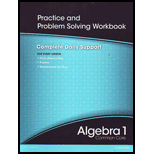
Concept explainers
There are 100 songs on your music player. In how many different ways can you arrange 20 songs to listen to while exercising?
Find the number of different ways that you can arrange 20 songs to listen to while exercising.
Answer to Problem 17P
Explanation of Solution
Given:
There are 100 songs on your music player.
Formula Used:
Calculation:
Since you need to arrange 20 songs , so the order of selection matters and select the 20 songs from 100 without replacement. So, the number of different ways that you can arrange 20 songs to listen to while exercising:
Chapter 12 Solutions
High School Math 2012 Common-core Algebra 1 Practice And Problem Solvingworkbook Grade 8/9
Additional Math Textbook Solutions
Basic Business Statistics, Student Value Edition
Thinking Mathematically (6th Edition)
College Algebra (7th Edition)
Calculus for Business, Economics, Life Sciences, and Social Sciences (14th Edition)
Calculus: Early Transcendentals (2nd Edition)
University Calculus: Early Transcendentals (4th Edition)
- 4. Select all of the solutions for x²+x - 12 = 0? A. -12 B. -4 C. -3 D. 3 E 4 F 12 4 of 10arrow_forward2. Select all of the polynomials with the degree of 7. A. h(x) = (4x + 2)³(x − 7)(3x + 1)4 B h(x) = (x + 7)³(2x + 1)^(6x − 5)² ☐ Ch(x)=(3x² + 9)(x + 4)(8x + 2)ª h(x) = (x + 6)²(9x + 2) (x − 3) h(x)=(-x-7)² (x + 8)²(7x + 4)³ Scroll down to see more 2 of 10arrow_forward1. If all of the zeros for a polynomial are included in the graph, which polynomial could the graph represent? 100 -6 -2 0 2 100 200arrow_forward
- 3. Select the polynomial that matches the description given: Zero at 4 with multiplicity 3 Zero at −1 with multiplicity 2 Zero at -10 with multiplicity 1 Zero at 5 with multiplicity 5 ○ A. P(x) = (x − 4)³(x + 1)²(x + 10)(x — 5)³ B - P(x) = (x + 4)³(x − 1)²(x − 10)(x + 5)³ ○ ° P(x) = (1 − 3)'(x + 2)(x + 1)"'" (x — 5)³ 51 P(r) = (x-4)³(x − 1)(x + 10)(x − 5 3 of 10arrow_forwardMatch the equation, graph, and description of transformation. Horizontal translation 1 unit right; vertical translation 1 unit up; vertical shrink of 1/2; reflection across the x axis Horizontal translation 1 unit left; vertical translation 1 unit down; vertical stretch of 2 Horizontal translation 2 units right; reflection across the x-axis Vertical translation 1 unit up; vertical stretch of 2; reflection across the x-axis Reflection across the x - axis; vertical translation 2 units down Horizontal translation 2 units left Horizontal translation 2 units right Vertical translation 1 unit down; vertical shrink of 1/2; reflection across the x-axis Vertical translation 2 units down Horizontal translation 1 unit left; vertical translation 2 units up; vertical stretch of 2; reflection across the x - axis f(x) = - =-½ ½ (x − 1)²+1 f(x) = x²-2 f(x) = -2(x+1)²+2 f(x)=2(x+1)²-1 f(x)=-(x-2)² f(x)=(x-2)² f(x) = f(x) = -2x²+1 f(x) = -x²-2 f(x) = (x+2)²arrow_forwardWhat is the vertex, increasing interval, decreasing interval, domain, range, root/solution/zero, and the end behavior?arrow_forward
- The augmented matrix of a linear system has been reduced by row operations to the form shown. Continue the appropriate row operations and describe the solution set of the original system. 1 -1 0 1 -2 00-4 0-6 0 0 1 - 3 3 0 001 4arrow_forwardSolve the system. X1 - 3x3 = 10 4x1 + 2x2 + 3x3 = 22 ×2 + 4x3 = -2arrow_forwardUse the quadratic formula to find the zeros of the quadratic equation. Y=3x^2+48x+180arrow_forward
- M = log The formula determines the magnitude of an earthquake, where / is the intensity of the earthquake and S is the intensity of a "standard earthquake." How many times stronger is an earthquake with a magnitude of 8 than an earthquake with a magnitude of 6? Show your work.arrow_forwardNow consider equations of the form ×-a=v = √bx + c, where a, b, and c are all positive integers and b>1. (f) Create an equation of this form that has 7 as a solution and an extraneous solution. Give the extraneous solution. (g) What must be true about the value of bx + c to ensure that there is a real number solution to the equation? Explain.arrow_forwardThe equation ×+ 2 = √3x+10 is of the form ×+ a = √bx + c, where a, b, and c are all positive integers and b > 1. Using this equation as a model, create your own equation that has extraneous solutions. (d) Using trial and error with numbers for a, b, and c, create an equation of the form x + a = √bx + c, where a, b, and c are all positive integers and b>1 such that 7 is a solution and there is an extraneous solution. (Hint: Substitute 7 for x, and choose a value for a. Then square both sides so you can choose a, b, and c that will make the equation true.) (e) Solve the equation you created in Part 2a.arrow_forward
 Algebra and Trigonometry (6th Edition)AlgebraISBN:9780134463216Author:Robert F. BlitzerPublisher:PEARSON
Algebra and Trigonometry (6th Edition)AlgebraISBN:9780134463216Author:Robert F. BlitzerPublisher:PEARSON Contemporary Abstract AlgebraAlgebraISBN:9781305657960Author:Joseph GallianPublisher:Cengage Learning
Contemporary Abstract AlgebraAlgebraISBN:9781305657960Author:Joseph GallianPublisher:Cengage Learning Linear Algebra: A Modern IntroductionAlgebraISBN:9781285463247Author:David PoolePublisher:Cengage Learning
Linear Algebra: A Modern IntroductionAlgebraISBN:9781285463247Author:David PoolePublisher:Cengage Learning Algebra And Trigonometry (11th Edition)AlgebraISBN:9780135163078Author:Michael SullivanPublisher:PEARSON
Algebra And Trigonometry (11th Edition)AlgebraISBN:9780135163078Author:Michael SullivanPublisher:PEARSON Introduction to Linear Algebra, Fifth EditionAlgebraISBN:9780980232776Author:Gilbert StrangPublisher:Wellesley-Cambridge Press
Introduction to Linear Algebra, Fifth EditionAlgebraISBN:9780980232776Author:Gilbert StrangPublisher:Wellesley-Cambridge Press College Algebra (Collegiate Math)AlgebraISBN:9780077836344Author:Julie Miller, Donna GerkenPublisher:McGraw-Hill Education
College Algebra (Collegiate Math)AlgebraISBN:9780077836344Author:Julie Miller, Donna GerkenPublisher:McGraw-Hill Education





